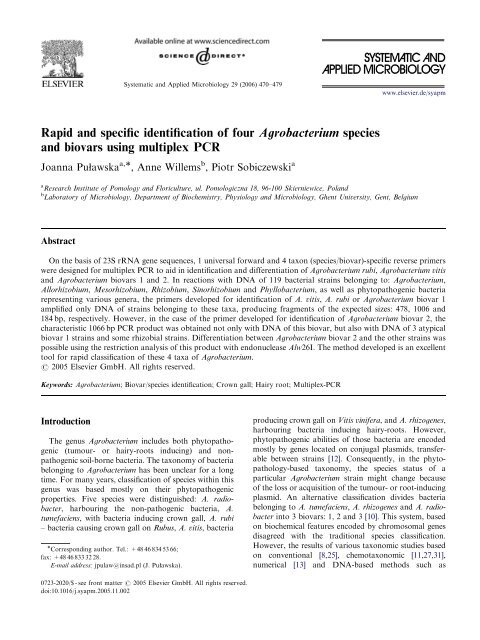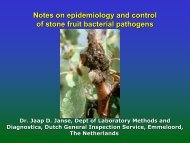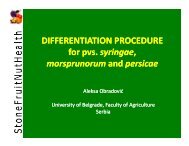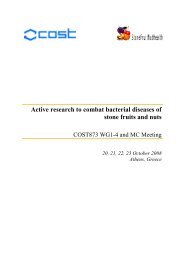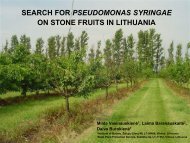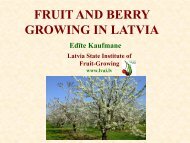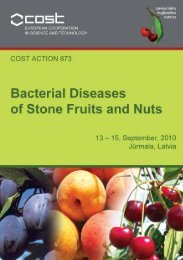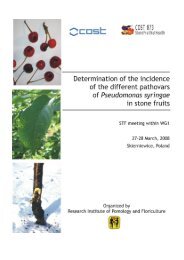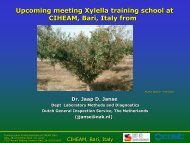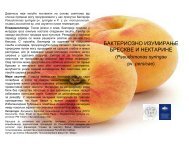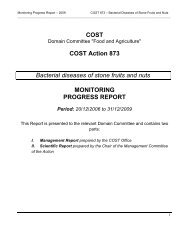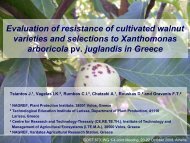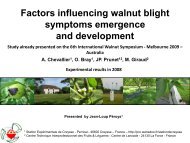Rapid and specific identification of four Agrobacterium ... - Cost 873
Rapid and specific identification of four Agrobacterium ... - Cost 873
Rapid and specific identification of four Agrobacterium ... - Cost 873
Create successful ePaper yourself
Turn your PDF publications into a flip-book with our unique Google optimized e-Paper software.
ARTICLE IN PRESSSystematic <strong>and</strong> Applied Microbiology 29 (2006) 470–479www.elsevier.de/syapm<strong>Rapid</strong> <strong>and</strong> <strong>specific</strong> <strong>identification</strong> <strong>of</strong> <strong>four</strong> <strong>Agrobacterium</strong> species<strong>and</strong> biovars using multiplex PCRJoanna Pu"awska a, , Anne Willems b , Piotr Sobiczewski aa Research Institute <strong>of</strong> Pomology <strong>and</strong> Floriculture, ul. Pomologiczna 18, 96-100 Skierniewice, Pol<strong>and</strong>b Laboratory <strong>of</strong> Microbiology, Department <strong>of</strong> Biochemistry, Physiology <strong>and</strong> Microbiology, Ghent University, Gent, BelgiumAbstractOn the basis <strong>of</strong> 23S rRNA gene sequences, 1 universal forward <strong>and</strong> 4 taxon (species/biovar)-<strong>specific</strong> reverse primerswere designed for multiplex PCR to aid in <strong>identification</strong> <strong>and</strong> differentiation <strong>of</strong> <strong>Agrobacterium</strong> rubi, <strong>Agrobacterium</strong> vitis<strong>and</strong> <strong>Agrobacterium</strong> biovars 1 <strong>and</strong> 2. In reactions with DNA <strong>of</strong> 119 bacterial strains belonging to: <strong>Agrobacterium</strong>,Allorhizobium, Mesorhizobium, Rhizobium, Sinorhizobium <strong>and</strong> Phyllobacterium, as well as phytopathogenic bacteriarepresenting various genera, the primers developed for <strong>identification</strong> <strong>of</strong> A. vitis, A. rubi or <strong>Agrobacterium</strong> biovar 1amplified only DNA <strong>of</strong> strains belonging to these taxa, producing fragments <strong>of</strong> the expected sizes: 478, 1006 <strong>and</strong>184 bp, respectively. However, in the case <strong>of</strong> the primer developed for <strong>identification</strong> <strong>of</strong> <strong>Agrobacterium</strong> biovar 2, thecharacteristic 1066 bp PCR product was obtained not only with DNA <strong>of</strong> this biovar, but also with DNA <strong>of</strong> 3 atypicalbiovar 1 strains <strong>and</strong> some rhizobial strains. Differentiation between <strong>Agrobacterium</strong> biovar 2 <strong>and</strong> the other strains waspossible using the restriction analysis <strong>of</strong> this product with endonuclease Alw26I. The method developed is an excellenttool for rapid classification <strong>of</strong> these 4 taxa <strong>of</strong> <strong>Agrobacterium</strong>.r 2005 Elsevier GmbH. All rights reserved.Keywords: <strong>Agrobacterium</strong>; Biovar/species <strong>identification</strong>; Crown gall; Hairy root; Multiplex-PCRIntroductionThe genus <strong>Agrobacterium</strong> includes both phytopathogenic(tumour- or hairy-roots inducing) <strong>and</strong> nonpathogenicsoil-borne bacteria. The taxonomy <strong>of</strong> bacteriabelonging to <strong>Agrobacterium</strong> has been unclear for a longtime. For many years, classification <strong>of</strong> species within thisgenus was based mostly on their phytopathogenicproperties. Five species were distinguished: A. radiobacter,harbouring the non-pathogenic bacteria, A.tumefaciens, with bacteria inducing crown gall, A. rubi– bacteria causing crown gall on Rubus, A. vitis, bacteria Corresponding author. Tel.: +48 46 834 53 66;fax: +48 46 833 32 28.E-mail address: jpulaw@insad.pl (J. Pu"awska).producing crown gall on Vitis vinifera, <strong>and</strong>A. rhizogenes,harbouring bacteria inducing hairy-roots. However,phytopathogenic abilities <strong>of</strong> those bacteria are encodedmostly by genes located on conjugal plasmids, transferablebetween strains [12]. Consequently, in the phytopathology-basedtaxonomy, the species status <strong>of</strong> aparticular <strong>Agrobacterium</strong> strain might change because<strong>of</strong> the loss or acquisition <strong>of</strong> the tumour- or root-inducingplasmid. An alternative classification divides bacteriabelonging to A. tumefaciens, A. rhizogenes <strong>and</strong> A. radiobacterinto 3 biovars: 1, 2 <strong>and</strong> 3 [10]. This system, basedon biochemical features encoded by chromosomal genesdisagreed with the traditional species classification.However, the results <strong>of</strong> various taxonomic studies basedon conventional [8,25], chemotaxonomic [11,27,31],numerical [13] <strong>and</strong> DNA-based methods such as0723-2020/$ - see front matter r 2005 Elsevier GmbH. All rights reserved.doi:10.1016/j.syapm.2005.11.002
ARTICLE IN PRESSJ. Pu"awska et al. / Systematic <strong>and</strong> Applied Microbiology 29 (2006) 470–479 471DNA:DNA hybridization [5], sequenceanalysis<strong>of</strong>16SrDNA [26,33] <strong>and</strong> 23S rDNA [23] indicate that biovaridentity <strong>of</strong> <strong>Agrobacterium</strong> is a reliable taxonomic trait.These studies also showed that the genus <strong>Agrobacterium</strong>is closely related <strong>and</strong> even entwined with bacteriabelonging to Rhizobium, Sinorhizobium <strong>and</strong> Mesorhizobium.Based on these results several proposals <strong>of</strong>nomenclature changes within <strong>Agrobacterium</strong> were presented[9,26] including the latest one suggesting rejection<strong>of</strong> this genus <strong>and</strong> incorporation <strong>of</strong> agrobacteria toRhizobium [34]. However, this proposal is not generallyaccepted [7] <strong>and</strong> therefore, we prefer to use the<strong>Agrobacterium</strong> nomenclature instead <strong>of</strong> the Rhizobium.Until now, no rapid, PCR-based system for <strong>identification</strong><strong>of</strong> taxa within the genus <strong>Agrobacterium</strong> has beenavailable to phytopathologists. However, such a methodwould be very useful in classification <strong>of</strong> isolated crowngall <strong>and</strong> hairy roots causal agents to biovar or species,because some species, e.g. A. rubi <strong>and</strong> A. vitis show hostspecialization. This kind <strong>of</strong> tool would be also helpful inecological studies on soil-borne bacteria. At present,classification <strong>of</strong> agrobacteria is performed most <strong>of</strong>ten onthe basis <strong>of</strong> several biochemical tests, which aregenerally time-consuming <strong>and</strong> labour intensive [18],even when modified into a microtiter system [2].The aim <strong>of</strong> our study was to develop a multiplex PCRsystem, based on the differences in sequences <strong>of</strong> 23SrRNA gene, for fast <strong>identification</strong> <strong>of</strong> <strong>Agrobacterium</strong>biovar 1, biovar 2, A. rubi, <strong>and</strong>A. vitis.1 mM EDTA pH 8.0). To lyse the cells, 200 ml <strong>of</strong> buffer(0.25% SDS, 0.2 M NaOH) was added <strong>and</strong> then themixture was incubated at 70 1C for 15 min. Next 200 ml<strong>of</strong> 5 M NaCl solution was added, the mixture wascarefully mixed <strong>and</strong> incubated on ice for 15 min.After centrifugation (10 min at 15 000g) DNA wasprecipitated with 2 volumes <strong>of</strong> cold EtOH at roomtemperature. The pellet was washed with 70% EtOH,dried <strong>and</strong> dissolved in 500 ml <strong>of</strong> 10 mM Tris-HCl buffer,pH 8.2.Primer designFive primers were designed on the basis <strong>of</strong> thenucleotide sequence <strong>of</strong> the 23S rDNA determined for12 <strong>Agrobacterium</strong>, 2 Sinorhizobium <strong>and</strong> 4 Rhizobiumstrains [23] <strong>and</strong> 23S rDNA sequences <strong>of</strong> related bacteriaobtained from GenBank (U45329, U28505, L39095,X88894, Z35330, X71840, X87283, X71839). One <strong>of</strong>them, UF, is a universal forward primer complementaryto 23S rDNA sequences <strong>of</strong> all agrobacteria. Four othersare reverse primers, each complementary to DNA <strong>of</strong> adifferent species/biovar <strong>of</strong> <strong>Agrobacterium</strong>: B1R – toDNA <strong>of</strong> biovar 1 strains, B2R – to biovar 2 strains, AvR–toA. vitis (ex biovar 3 strains) <strong>and</strong> ArR – to A. rubi(Table 3). All primers were checked for homology toother sequences in the GenBank <strong>and</strong> EMBL databasesusing the BLAST N program.Specificity <strong>of</strong> developed primersMaterials <strong>and</strong> methodsBacterial strainsAll bacterial strains used in this study are presented inTable 1. The <strong>Agrobacterium</strong>, Erwinia, Pseudomonas <strong>and</strong>Xanthomonas strains were grown on King’s B medium[14], strains <strong>of</strong> Allorhizobium, Mesorhizobium, Rhizobium<strong>and</strong> Sinorhizobium – on mannitol–yeast extractmedium (79 CA) [32] <strong>and</strong> Phyllobacterium – on nutrientagar with beef extract (Oxoid CM3). For the <strong>Agrobacterium</strong>strains with unknown identity, the biovar orspecies status was assessed on the basis <strong>of</strong> a set <strong>of</strong>biochemical tests: 3-ketolactose production, citrate <strong>and</strong>L-tyrosine utilization, growth <strong>and</strong> pigmentation in ferricammonium citrate broth, acid from erythritol <strong>and</strong>oxidase reaction [18] (Table 2).Total bacterial DNA preparationsTotal bacterial DNA was extracted using a methoddescribed by Sambrook et al. [24] in own modification.For DNA isolation bacteria taken from 1 colony wereresuspended in 100 ml <strong>of</strong> TE buffer (10 mM Tris-HCl,DNA <strong>of</strong> each bacterial strain (Table 1) was tested inseparate PCRs with the following sets <strong>of</strong> primers: (i)UF+B1R, (ii) UF+B2R, (iii) UF+AvR, (iv)UF+ArR <strong>and</strong> in a multiplex PCR with primersUF+B1R+B2R+AvR+ArR. DNA amplificationwas performed in total volume <strong>of</strong> 15 ml in ThermalCycler Trio – Thermoblock (Biometra, Germany). Allreactions were performed in PCR buffer (10 mM Tris-HCl, pH 9.0; 50 mM KCl; 0.1% Triton X-100) with1.5 mM MgCl 2 , 200 mM <strong>of</strong> each dNTP, 1 mM <strong>of</strong>eachprimer <strong>and</strong> 1 U <strong>of</strong> thermostable DNA polymerase(Promega, Madison, USA). The optimal amplificationconditions were determined experimentally: initial denaturationat 94 1C for 1 min, followed by 35 cycles <strong>of</strong>denaturation at 94 1C for 1 min, annealing at 67 1C for1 min, extension at 72 1C for 1.5 min <strong>and</strong> a finalextension step for 10 min. PCR products were analyzedby electrophoresis through 2% agarose gel. Each<strong>Agrobacterium</strong> strain was tested at least twice.Restriction analysisFor differentiation between strains <strong>of</strong> <strong>Agrobacterium</strong>biovar 2 <strong>and</strong> other representatives <strong>of</strong> family
472Table 1.Strains used in this studyARTICLE IN PRESSJ. Pu"awska et al. / Systematic <strong>and</strong> Applied Microbiology 29 (2006) 470–479Strain Source <strong>and</strong> location Fragments produced in multiplex PCR with primersUF+B1R+B2R+AvR+ArRBiovar 1(184 bp)Biovar 2(1066 bp)A.vitis(478 bp)A. rubi(1006 bp)PCR-RFLP <strong>of</strong>UF+B2Rproduct aBiovar 1g-114-3-2 Unknown; Israel + nt32/1 Apple; Hungary + nt7/1 Raspberry; Hungary + + 365 Raspberry; Hungary + nt39/7 Plum; Hungary + + 3CFBP 2516, CFBP Poplar; France + nt2519,CFBP 2177B6 Tomato; France + ntC58 Sweet cherry; USA + ntT37 Unknown; France + ntACH5 Unknown; Belgium + ntAT4, 137 Cherry; Pol<strong>and</strong> + nt6 Cherry; Hungary + ntCh3, Ch6Chrysanthemum; + ntPol<strong>and</strong>13B Unknown; Israel + nt0 Grapevine; Hungary + + 3131a/b Apple; Pol<strong>and</strong> + ntBiovar 2K84 Peach; Australia + 2LMG 150 Apple; Unknown + 2K27 Poplar; Australia + 215b/94, 21/94, 307a, Apple; Pol<strong>and</strong> + 258031a/b, 32a, 32b, 39, Cherry; Pol<strong>and</strong> + 240, 88, 101, 107, 125,126, 129, 133, 301,387, 389, 392, 40046, 182, 192, 262 Pear; Pol<strong>and</strong> + 2122, 568 Plum; Pol<strong>and</strong> + 2103, 104 Peach; Pol<strong>and</strong> + 260, 67, 69, 71, 77, 81, Sweet cherry; Pol<strong>and</strong> + 283, 84, 89, 221b, 36530/2, 9 Peach; Hungary + 28/1, 51, 9/2 Raspberry; Hungary + 2P-Ag- 1, 2, 3, 4, 6 Pear; Japan + 2Pch-Ag- 2, 3, 4, 5, 6 Peach; Japan + 2A. vitisLMG 8750 Grapevine; Australia + ntAg162 Grapevine; Grecja + nt2/3 S5R, AB3, AB4, Grapevine; Hungary + ntTm4g-114-5-IV-1 Grapevine; Israel + ntCG49 Grapevine; USA + ntA. rubiLMG 156 Boysenberry; USA + ntLMG 159 Black raspberry; USA + ntLMG 294Eunonymus sp.;+ ntFranceA. larrymooreiLMG 21410Ficus benjaminant
ARTICLE IN PRESSJ. Pu"awska et al. / Systematic <strong>and</strong> Applied Microbiology 29 (2006) 470–479 473Table 1. (continued )Strain Source <strong>and</strong> location Fragments produced in multiplex PCR with primersUF+B1R+B2R+AvR+ArRBiovar 1(184 bp)Biovar 2(1066 bp)A.vitis(478 bp)A. rubi(1006 bp)PCR-RFLP <strong>of</strong>UF+B2Rproduct a<strong>Agrobacterium</strong>unclassifiedCh11, Ch12Chrysanthemum;ntPol<strong>and</strong>47/7 Peach; Hungary + ntAllorhizobium undicolaLMG 11875Bradyrhizobiumjaponicum 94pMesorhizobium lotiLMG 6125PhyllobacteriummyrsinacearumLMG 2P. rubiacearumLMG 1Rhizobium etliUSDA 9032Neptunia natans;SenegalSoybean; ?Lotus; New Zeal<strong>and</strong>Ardisia crispa;Germany+ 3Pavettantzimmermannia;GermanyBean; Mexico + 3R. galegaeLMG 6214 Goat’s rue; Finl<strong>and</strong> ntLMG 6215Goat’s rue; formerUSSR.ntR. huautlense SO2 Sesbania herbacea;MexicoR. leguminosarumbv. viciae PRE Pea; Hol<strong>and</strong> ntbv. trifoliiLMG 8820Trifolium; ? + 3R. tropici ntLMG 9503 Bean; Columbia + 3LMG 9517 Bean; Brazil ntUT 30011O Bean; Mexico + 3Sinorhizobium frediiLMG 6217Soybean; China + 3S. melilotia18 Alfalfa; Pol<strong>and</strong> + 3LMG 6133 Alfalfa; ? + 3S. saheli LMG 7837 Sesbania cannabina;+ 3SenegalS. teranga LMG 7834 Acacia laeta; Senegal + 3Arthrobacter ramosus Unknown; Pol<strong>and</strong> ntArthrobacterUnknown; Pol<strong>and</strong>ntglobiformisArthrobacter pascens Unknown; Pol<strong>and</strong> ntErwinia amylovora 659 Apple; Pol<strong>and</strong> ntErwinia herbicola 801 Chrysanthemum;Pol<strong>and</strong>ntntntntnt
474ARTICLE IN PRESSJ. Pu"awska et al. / Systematic <strong>and</strong> Applied Microbiology 29 (2006) 470–479Table 1. (continued )Strain Source <strong>and</strong> location Fragments produced in multiplex PCR with primersUF+B1R+B2R+AvR+ArRBiovar 1(184 bp)Biovar 2(1066 bp)A.vitis(478 bp)A. rubi(1006 bp)PCR-RFLP <strong>of</strong>UF+B2Rproduct aPseudomonas syringaepv. tomatoXanthomonas arboricolapv. pruniUnknown; Pol<strong>and</strong>Unknown; Unknownntnta 2, two DNA fragments <strong>of</strong> 1006 bp <strong>and</strong> 60 bp were obtained as a result <strong>of</strong> RFLP with Alw26I; 3, three DNA fragments <strong>of</strong> 830 bp, 167 bp <strong>and</strong> 60 bpwere obtained; nt, not tested.Table 2.Characteristic <strong>of</strong> phenotypic features <strong>of</strong> some <strong>Agrobacterium</strong> strains testedStrain 3-ketolactoseproductionCitrateutilizationL-tyrosineutilizationFerricammoniumcitrateAcid fromerythritolNaCltolerance(%)Oxidase c<strong>Agrobacterium</strong> B6 T (bv.1) + + 4 +<strong>Agrobacterium</strong> Ch 3, 131a/b + + 3 +<strong>Agrobacterium</strong> Ch-6, 137, 6, + + 4 +CFBP 2519<strong>Agrobacterium</strong> 0, 39/7, 7/1 + 4 +<strong>Agrobacterium</strong> LMG 150 T+ + + 1(bv.2)<strong>Agrobacterium</strong> 400 + + + 1 +/<strong>Agrobacterium</strong> 77 + + + 1A. vitis LMG 8750 T + 3 +A. rubi LMG 156 T nt 4 +<strong>Agrobacterium</strong> Ch-11 5 +<strong>Agrobacterium</strong> Ch-12 3 +/<strong>Agrobacterium</strong> 47/7 + + 3 +T , type strain; nt, not tested.Table 3.<strong>Agrobacterium</strong> species/biovar-<strong>specific</strong> primers based on 23S rDNA sequencesName <strong>of</strong> primer Target position a Sequence (5 0 –3 0 )UF f 171–193 GTAAGAAGCGAACGCAGGGAACTB1R r 338–360 GACAATGACTGTTCTACGCGTAAB2R r 1207–1230 TCCGATACCTCCAGGGCCCCTCACAAvR r 640–662 AACTAACTCAATCGCGCTATTAACArR r 1150–1173 AAAACAGCCACTACGACTGTCTTf, forward; r, reverse.a E. coli position numbering [1].Rhizobiaceae which produced a 1066 bp amplificationproduct with primers UF+B2R (Table 1),the restriction analysis <strong>of</strong> this product was applied.On the basis <strong>of</strong> computer analysis, endonucleaseAlw26I was chosen as the most appropriate for thispurpose. For each reaction 50 ng <strong>of</strong> PCR product wasused. Restriction fragments were separated in 2%agarose gels.
ARTICLE IN PRESSJ. Pu"awska et al. / Systematic <strong>and</strong> Applied Microbiology 29 (2006) 470–479 475SDS-PAGE <strong>of</strong> whole-cell proteinsWhole-cell protein extracts were prepared <strong>and</strong> separatedby electrophoresis using slight modifications <strong>of</strong> theprocedure <strong>of</strong> Laemmli [16] as described by de Lajudieet al. [4].Results <strong>and</strong> discussionPresented study allowed to develop a rapid methodfor <strong>identification</strong> <strong>and</strong> differentiation <strong>of</strong> 4 taxa belongingto genus <strong>Agrobacterium</strong> using multiplex PCR withprimers complementary to the 23S rRNA gene. Up tonow, analysis <strong>of</strong> phenotypic features based on biochemicaltests has been the phytopathologist’s st<strong>and</strong>ardmethod to classify agrobacteria into biovar 1, biovar2, A. vitis <strong>and</strong> A. rubi [18]. However, unambiguousclassification <strong>of</strong> agrobacteria into a particular taxon islaborious <strong>and</strong> time-consuming, <strong>and</strong> the results are very<strong>of</strong>ten difficult to interpret. Modern systems <strong>of</strong> bacterial<strong>identification</strong> exploit techniques based on analysis <strong>of</strong>sequences <strong>of</strong> functional genes. One <strong>of</strong> the most <strong>of</strong>tenused for this purpose is the gene coding for 16S rRNA.Systems based on this gene were developed for rapid<strong>identification</strong> <strong>of</strong> bacteria belonging to genera Bifidobacterium[6], Mycobacterium, Nocardia <strong>and</strong> others (reviewedin [15]). However, among agrobacteria thedivergence in sequences <strong>of</strong> 16S rDNA is not highenough for this system to be effective. For example,dissimilarity between 16S rDNA sequences <strong>of</strong> A. rubi<strong>and</strong> <strong>Agrobacterium</strong> biovar 1 is only 1.5%, which limitsthe possibilities for developing primers or probesdifferentiating these 2 taxa [26,33]. Mougel et al. [19]designed probes complementary to 16S rDNA, whichallow the discrimination <strong>of</strong> biovar 2, but not biovar 1agrobacteria <strong>and</strong> A. rubi. The gene coding for 23SrRNA contains more information than that for 16SrRNA <strong>and</strong> has already been used for <strong>identification</strong> <strong>of</strong>bacteria <strong>of</strong> other genera [17,30]. In the case <strong>of</strong><strong>Agrobacterium</strong>, higher dissimilarity between sequences<strong>of</strong> all species/biovars was found for this gene. Forinstance, differences between 23S rDNA sequences <strong>of</strong>biovar 1 agrobacteria <strong>and</strong> A. rubi ranged from 2.37% to3.09% [23], <strong>of</strong>fering more scope for the development <strong>of</strong><strong>specific</strong> primers. Similar results were obtained also byPeplies et al. [20], who in study on oligonucleotide probedesign for some marine Alphaproteobacteria found that23S rRNA gene has up to 8 times more discriminatorysites than 16S rRNA.Based on BLAST N analysis, 4 <strong>of</strong> the developedprimers, UF, B2R, AvR <strong>and</strong> ArR showed 100%homology only to the 23S rDNA sequences <strong>of</strong> the taxathey were designed to identify. The sequence <strong>of</strong> primerB1R, in addition to homology to 23S rDNA sequence <strong>of</strong><strong>Agrobacterium</strong> biovar 1, also showed 100% homologyto gene sequences <strong>of</strong> A. rubi IAM 13569 (AY244376)<strong>and</strong> A. vitis IAM 14140 (AY244374). However, thesesequences may be misnamed, because on the basis <strong>of</strong>cluster analysis <strong>of</strong> all known 23S rDNA sequences <strong>of</strong>bacteria belonging to family Rhizobiaceae they are mostsimilar to sequences <strong>of</strong> biovar 1 strains <strong>of</strong> <strong>Agrobacterium</strong>,but not to other sequences <strong>of</strong> A. rubi (AF205373)<strong>and</strong> A. vitis (AF209071, AF209076, AY244370) strains(including the type strains) present in the publicdatabases.The <strong>specific</strong>ity <strong>of</strong> the newly developed primers wastested in PCRs using DNA <strong>of</strong> 119 bacterial strainsincluding: 93 <strong>of</strong> <strong>Agrobacterium</strong>, 19 <strong>of</strong> rhizobia <strong>and</strong> 7strains <strong>of</strong> phytopathogenic bacteria representing variousgenera. Primers developed for <strong>identification</strong> <strong>of</strong> bacteriaclassified as A. vitis, A. rubi <strong>and</strong> <strong>Agrobacterium</strong> biovar 1,amplified DNA <strong>of</strong> strains belonging only to these taxa<strong>and</strong> gave products <strong>of</strong> the expected sizes: 478, 1006 <strong>and</strong>184 bp, respectively. However, primer B2R, combinedwith primer UF, in addition to strains <strong>of</strong> <strong>Agrobacterium</strong>biovar 2, also amplified DNA <strong>of</strong> some (though not all)strains <strong>of</strong> other, closely related genera such as:Allorhizobium undicola, Rhizobium etli, R. leguminosarumbv. trifolii, R. tropici <strong>and</strong> all tested strains <strong>of</strong> thegenus Sinorhizobium. None <strong>of</strong> tested primers amplifiedDNA <strong>of</strong> strains belonging to A. larrymoorei, Phyllobacterium,Arthrobacter, Erwinia, Pseudomonas or Xanthomonas(Table 1). The results obtained in separate PCRswith following sets <strong>of</strong> primers: UF+B1R, UF+B2R,UF+AvR <strong>and</strong> UF+ArR were identical with thoseobtained in the PCRs, using all 5 primers simultaneously.Four PCR products <strong>of</strong> expected sizes wereobtained as a result <strong>of</strong> multiplex PCR with DNAmixture <strong>of</strong> representative strains <strong>of</strong> all <strong>Agrobacterium</strong>taxa (Fig. 1).As a result <strong>of</strong> DNA amplification with primers UF<strong>and</strong> B2R, a characteristic product <strong>of</strong> 1066 bp wasobtained in PCRs with DNA <strong>of</strong> 3 strains <strong>of</strong> <strong>Agrobacterium</strong>biovar 1, 58 strains <strong>of</strong> biovar 2 <strong>and</strong> 10 rhizobiastrains (Table 1). Restriction analysis <strong>of</strong> these productsusing endonuclease Alw26I allowed differentiation <strong>of</strong>biovar 2 strains from the other strains. The followingDNA fragments were obtained after digestion <strong>of</strong> the1066 bp PCR product <strong>of</strong> agrobacteria belonging tobiovar 2: 1006 <strong>and</strong> 60 bp, whereas in case <strong>of</strong> the otherbacteria 3 products (830, 167 <strong>and</strong> 60 bp, as expected onthe basis <strong>of</strong> computer analysis) were obtained (Table 1,Fig. 2).In case <strong>of</strong> strain 47/7, a 184 bp product typical forbiovar 1 was obtained as a result <strong>of</strong> amplification withprimers UF+B1R. However, this strain could not beclearly classified in biovar 1 on the basis <strong>of</strong> phenotypicfeatures. It showed typical features for biovar 2, such asthe ability to produce an acid from erythritol <strong>and</strong> it was3-ketolactose negative but at the same time showed
476ARTICLE IN PRESSJ. Pu"awska et al. / Systematic <strong>and</strong> Applied Microbiology 29 (2006) 470–479M 1 2 3 4 5 6 7 8 9 10 11 12 13M 1 2 3 4 5 6 7 8 9500 bp→Fig. 1. Electrophoresis gel showing PCR products obtained inmultiplex PCR with DNA <strong>of</strong> following <strong>Agrobacterium</strong> strains:1 – B6 (bv 1); 2 – LMG 150 (bv 2); 3 – LMG 8750 (A. vitis);4–LMG 156 (A. rubi); 5 – LMG 21410 (A. larrymoorei); 6 –mixture <strong>of</strong> DNA <strong>of</strong> strains B6, LMG 150, LMG 8750, LMG156 <strong>and</strong> LMG 21410; 7 – 47/7; 8 – 0; 9 – 7/1; 10 – 39/7; 11 –Ch11; 12 – Ch12; 13 – negative control; M – molecular weightmarker 100 bp ladder (Fermentas, Lithuania).500 bp→features typical for biovar 1 such as presence <strong>of</strong> oxidaseC as well as growth <strong>and</strong> pigmentation in ferricammonium citrate broth (Table 2). We verified its 16SrDNA sequence <strong>and</strong> found that 47/7 was 100% similarto that <strong>of</strong> <strong>Agrobacterium</strong> biovar 1 strain IAM 13129(accession no. D12784) <strong>and</strong> thus we can conclude it isindeed a biovar 1 strain (data unpublished).DNA <strong>of</strong> 3 other Hungarian strains (0, 7/1, 39/7) wasamplified both with primers complementary to 23SrDNA sequence <strong>of</strong> <strong>Agrobacterium</strong> biovar 1 <strong>and</strong> biovar2. As a result <strong>of</strong> amplification with the 5-primer mixture2 PCR products (184 <strong>and</strong> 1066 bp) were obtained(Fig. 1). Analysis <strong>of</strong> phenotypic features showed, thatthese 3 strains were most similar to biovar 1, except intheir ability to grow <strong>and</strong> produce pigment in ferricammonium citrate broth (Table 2). On the other h<strong>and</strong>,restriction analysis with Alw26I <strong>of</strong> products obtainedwith primers UF+B2R gave the same 3 fragments (830,167 <strong>and</strong> 60 bp) as those found for rhizobial strains butnot the 2 fragments (1006 <strong>and</strong> 60 bp) characteristic forbiovar 2. SDS-PAGE <strong>of</strong> total cellular proteins was usedas a rapid tool to screen for overall similarities <strong>of</strong> theHungarian strains <strong>and</strong> other taxa in our protein pr<strong>of</strong>iledatabase. It was found that these 3 strains producedsimilar protein patterns distinct from type strains <strong>of</strong>other biovars <strong>and</strong> species, but most similar to biovar 1strains (Fig. 3). They may represent a separate, hithertounrecognized taxon. The fact that none <strong>of</strong> the rhizobialstrains produced a product with the primer combinationUF+B1R as the Hungarian strains did, seems toconfirm that they may be a distinct group.Fig. 2. Restriction analysis with endonuclease Alw26I <strong>of</strong> PCRproducts obtained with primers UF+B2R. For comparisonnot digested product on lane 5 (1066 bp). Digestion fragments<strong>of</strong> UF+B2R PCR product <strong>of</strong> rhizobia (expected sizes: 830,167 <strong>and</strong> 60 bp): lane 1 – S. saheli LMG 7837; lane 2 – S.teranga LMG 7834; lane 3 – R. tropici LMG 9503; lane 4 – A.undicola LMG 11875. Digestion fragments <strong>of</strong> UF+B2R PCRproduct <strong>of</strong> some strains <strong>of</strong> agrobacteria biovar 2 (expectedsizes: 1006 <strong>and</strong> 60 bp): lane 6 – 39; lane 7 – LMG 150; lane 8 –K84; lane 9 – 129; lane 10 – 89. M – molecular weight marker100 bp ladder (Promega, USA).DNA <strong>of</strong> 2 <strong>Agrobacterium</strong> strains (Ch11 <strong>and</strong> Ch12)isolated from galls on chrysanthemum plants was notamplified with any set <strong>of</strong> primers, which suggests thatthey do not belong to any <strong>of</strong> the present biovars orspecies <strong>of</strong> <strong>Agrobacterium</strong>. Phenotypic characteristicsindicated that these strains are most similar to the A.rubi-type strain (Table 2), but FAME <strong>and</strong> RAPDanalysis did not confirm unambiguously their affinityto A. rubi [21]. Further studies should determine theirtaxonomic status.The method presented here is the first PCR-basedprotocol developed for <strong>identification</strong> <strong>and</strong> differentiation<strong>of</strong> bacteria belonging to biovars 1 <strong>and</strong> 2 <strong>of</strong> <strong>Agrobacterium</strong>,A. vitis <strong>and</strong> A. rubi. However, for discriminationbetween strains <strong>of</strong> biovar 2 <strong>and</strong> some rhizobia species
ARTICLE IN PRESSJ. Pu"awska et al. / Systematic <strong>and</strong> Applied Microbiology 29 (2006) 470–479 4775060708090100M. huakuii LMG 14107M. plurifarium LMG11892 TA. rhizogenes LMG 150M. ciceri LMG 14989 TR. huautlense LMG 18254<strong>Agrobacterium</strong> sp. 39/7<strong>Agrobacterium</strong> sp. 7/1<strong>Agrobacterium</strong> sp. 0A. radiobacter (bv. 1) LMG140 TA. tumefaciens (bv. 1) LMG 232A. tumefaciens (bv. 1) LMG 243A. tumefaciens (bv. 1) LMG 52A. larrymoorei LMG 21410 TA. tumefaciens (bv. 1) LMG 187 TS. terangae LMG 7834 TB. japonicum LMG 6138 TAz. caulinodans LMG6465 TS. arboris LMG15624S. saheli LMG 7837 TR. galegae LMG 6214 TR. leguminosarum LMG 8817 TR. tropici LMG 9503 TR. tropici LMG 9517M. loti LMG 6125 TS. kostiense LMG 15610S. meliloti LMG 6130S. meliloti LMG 6133 TR. etli CFN42 TS. medicae LMG 16580S. fredii LMG 6217 TR. mongolense LMG 19141M. mediterraneum LMG17148 TM. tianshanense LMG15767 TA. tumefaciens (bv. 1) LMG 37R. hainanense LMG 18075A. vitis LMG8750 TAl. undicola LMG 11874Fig. 3. Dendrogram showing the similarities between the SDS-PAGE protein pr<strong>of</strong>iles <strong>of</strong> Hungarian strains 39/7, 7/1, 0 <strong>and</strong> aselection <strong>of</strong> reference strains. Using the program GelCompar v. 4.2, the Pearson product moment correlation coefficient wascalculated <strong>and</strong> converted to percentage values. The similarities are represented as a UPGMA (unweighted pair grouping methodusing averages) dendrogram.(Allorhizobium undicola, Rhizobium etli, R. leguminosarumbv. trifolii, R. tropici <strong>and</strong> tested Sinorhizobium sp.) itis necessary to carry out RFLP analysis <strong>of</strong> the obtained1066 bp PCR product. Although as inferred fromtheoretical analysis, the primer B2R was expected tobe 100% complementary only to 23S rDNA <strong>of</strong> biovar 2strains, it also allowed amplification in some strains <strong>of</strong>rhizobia. This may be due to the fact that all rhizobialstrains producing the typical 1066 bp amplicon withprimers UF+B2R, are phylogeneticaly closely relatedto agrobacteria, as is apparent from 16S rDNAphylogeny [3,34]. Similarity <strong>of</strong> 23S rDNA <strong>of</strong> <strong>Agrobacterium</strong>biovar 2 <strong>and</strong> some rhizobia is very high. In somecases, 23S rDNA sequences <strong>of</strong> biovar 2 strains are evenmore similar to the same gene sequence <strong>of</strong> rhizobia (e.g.R. tropici) than to those <strong>of</strong> other <strong>Agrobacterium</strong> biovar/species [23].The presented method we use for fast <strong>identification</strong><strong>and</strong> classification <strong>of</strong> isolated agrobacteria from plants<strong>and</strong> soil. Simultaneous application <strong>of</strong> primers complementaryto tms2 gene which amplify DNA <strong>of</strong> onlytumour inducing strains [22,29] or pathogenicity tests onplants [28] allows for complete characterization <strong>of</strong>studied agrobacteria. The developed method should behelpful in phytopathological <strong>and</strong> ecological studies.AcknowledgmentsThe authors wish to thank J.H. Haas, S. Su¨le,X.Nesme,M. Maes, H. Sawada, S. Martyniuk, H. Bagin´ska for
478ARTICLE IN PRESSJ. Pu"awska et al. / Systematic <strong>and</strong> Applied Microbiology 29 (2006) 470–479providing bacterial strains. J. Pu"awska is deeply indebtedto the Foundation for Polish Science for NationalScholarship for Young Scientist (Edition 2001/2002).A. Willems is grateful to the Fund for ScientificResearch – Fl<strong>and</strong>ers for a postdoctoral research fellowship.This work was supported by Polish Scientific Committee(KBN) Grant 5P06A02119.References[1] J. Brosius, T.J. Dull, D.D. Sleeter, H.F. Noller, Geneorganization <strong>and</strong> primary structure <strong>of</strong> a ribosomal RNAoperon from Escherichia coli, J. Mol. Biol. 148 (1981)107–127.[2] J. Cubero, M.M. Lopez, An efficient microtiter system todetermine <strong>Agrobacterium</strong> biovar, Eur. J. Plant Pathol. 107(2001) 757–760.[3] P. de Lajudie, E. Laurent-Fulele, A. Willems, U. Torck,R. Coopman, M.D. Collins, K. Kersters, B. Dreyfus, M.Gillis, Allorhizobium undicola gen. nov., sp. nov., nitrogen-fixingbacteria that efficiently nodulate Neptunianatans in Senegal, Int. J. Syst. Bacteriol. 48 (1998)1277–1290.[4] P. de Lajudie, A. Willems, B. Pot, D. Dewettinck,G. Maestrojuan, M. Neyra, M.D. Collins, B. Dreyfus,K. Kersters, M. Gillis, Polyphasic taxonomy <strong>of</strong> rhizobia:emendation <strong>of</strong> the genus Sinorhizobium <strong>and</strong> description <strong>of</strong>Sinorhizobium meliloti comb. nov., Sinorhizobium sahelisp. nov., <strong>and</strong> Sinorhizobium teranga sp. nov., Int. J. Syst.Bacteriol. 44 (1994) 715–733.[5] J. De Ley, R. Tijtgat, J. De Smedt, M. Michiels,Thermal stability <strong>of</strong> DNA:DNA hybrids within thegenus <strong>Agrobacterium</strong>, J. Gen. Microbiol. 78 (1973)241–252.[6] X. Dong, G. Cheng, W. Jian, Simultaneous <strong>identification</strong><strong>of</strong> five Bifidobacterium species isolated from human beingsusing multiple PCR primers, Syst. Appl. Microbiol. 23(2000) 386–390.[7] S.K. Farr<strong>and</strong>, P.B. van Berkum, P. Oger, <strong>Agrobacterium</strong>is a definable genus <strong>of</strong> the family Rhizobiaceae, Int.J. Syst. Evol. Microbiol. 53 (2003) 1681–1687.[8] B. Holmes, Taxonomy <strong>of</strong> <strong>Agrobacterium</strong>, Acta Hortic.225 (1988) 47–52.[9] B. Holmes, P. Roberts, The classification, <strong>identification</strong><strong>and</strong> nomenclature <strong>of</strong> agrobacteria, J. Appl. Bacteriol. 50(1981) 443–467.[10] J.G. Holt, N.R. Krieg, P.H.A. Sneath, J.T. Staley, S.T.Williams, Bergey’s Manual <strong>of</strong> Determinative Bacteriology,ninth ed., Williams & Wilkins Comp., Baltimore,MD, USA, 1994.[11] B.D.W. Jarvis, S. Sivakumaran, S.W. Tighe, M. Gillis,Identification <strong>of</strong> <strong>Agrobacterium</strong> <strong>and</strong> Rhizobium speciesbased on cellular fatty acid composition, Plant Soil 184(1996) 143–158.[12] A. Kerr, P. Manigault, J. Tempé, Transfer <strong>of</strong> virulence invivo <strong>and</strong> in vitro in <strong>Agrobacterium</strong>, Nature 265 (1977)560–561.[13] K. Kersters, J. De Ley, P.H.A. Sneath, M. Sackin,Numerical taxonomic analysis <strong>of</strong> <strong>Agrobacterium</strong>, J. Gen.Microbiol. 78 (1973) 227–239.[14] E.O. King, M.K. Ward, D.E. Raney, Two simple mediafor the demonstration <strong>of</strong> pyocyanin <strong>and</strong> fluorescein,J. Lab. Med. 44 (1954) 693–695.[15] C.P. Kolbert, D.H. Persing, Ribosomal DNA sequencingas a tool for <strong>identification</strong> <strong>of</strong> bacterial pathogens, Curr.Opin. Microbiol. 2 (1999) 299–305.[16] U.K. Laemmli, Cleavage <strong>of</strong> structural proteins duringassembly <strong>of</strong> the head <strong>of</strong> bacteriophage T4, Nature 227(1970) 680–685.[17] W. Ludwig, S. Dorn, N. Springer, G. Kirchh<strong>of</strong>, K.H.Schleifer, PCR-based preparation <strong>of</strong> 23S rRNA-targetedgroup-<strong>specific</strong> polynucleotide probes, Appl. Environ.Microbiol. 60 (1994) 3234–3244.[18] L.W. Moore, C.I. Kado, H. Bouzar, II Gram-negativebacteria A, <strong>Agrobacterium</strong>, In: N.W. Schaad (Ed.),Laboratory Guide for Identification <strong>of</strong> Plant PathogenicBacteria, American Phytopathological Society, St. Paul,MN, 1988, pp. 16–36.[19] C. Mougel, B. Cournoyer, X. Nesme, Novel telluriteamendedmedia <strong>and</strong> <strong>specific</strong> chromosomal <strong>and</strong> Ti plasmidprobes for direct analysis <strong>of</strong> soil populations <strong>of</strong> <strong>Agrobacterium</strong>biovars 1 <strong>and</strong> 2, Appl. Environ. Microbiol. 67(2001) 65–74.[20] J. Peplies, F.O. Glo¨ckner, R. Amann, W. Ludwig,Comparative sequence analysis <strong>and</strong> oligonucleotide probedesign based on 23S rRNA genes <strong>of</strong> Alphaproteobacteriafrom North Sea bacterioplankton, Syst. Appl. Microbiol.27 (2004) 573–580.[21] J. Pu"awska, Z. Piotrowska-Seget, Characterization <strong>of</strong><strong>Agrobacterium</strong> isolates from chrysanthemum on the basis<strong>of</strong> biochemical tests, FAME analysis <strong>and</strong> RAPD,Phytopathol. Pol. 30 (2003) 9–17.[22] J. Pu"awska, P. Sobiczewski, Development <strong>of</strong> a seminestedPCR based method for sensitive detection <strong>of</strong>tumorigenic <strong>Agrobacterium</strong> in soil, J. Appl. Microbiol. 98(2005) 710–721.[23] J. Pu"awska, M. Maes, A. Willems, P. Sobiczewski,Phylogenetic analysis <strong>of</strong> 23S rRNA gene sequences <strong>of</strong><strong>Agrobacterium</strong>, Rhizobium <strong>and</strong> Sinorhizobium strains,Syst. Appl. Microbiol. 23 (2000) 238–244.[24] J. Sambrook, E.F. Fritsch, T. Maniatis, MolecularCloning, A Laboratory Manual, second ed., Cold SpringHarbor Laboratory Press, Cold Spring Harbor, NY,1989.[25] H. Sawada, H. Ieki, Phenotypic characteristics <strong>of</strong> thegenus <strong>Agrobacterium</strong>, Ann. Phytopathol. Soc. Jpn. 58(1992) 37–45.[26] H. Sawada, H. Ieki, H. Oyaizu, S. Matsumoto, Proposalfor rejection <strong>of</strong> <strong>Agrobacterium</strong> tumefaciens <strong>and</strong> reviseddescription for the genus <strong>Agrobacterium</strong> <strong>and</strong> for <strong>Agrobacterium</strong>radiobacter <strong>and</strong> <strong>Agrobacterium</strong> rhizogenes, Int.J. Syst. Bacteriol. 43 (1993) 694–702.[27] H. Sawada, Y. Takikawa, H. Ieki, Fatty acid methyl esterpr<strong>of</strong>iles <strong>of</strong> the genus <strong>Agrobacterium</strong>, Ann. Phytopathol.Soc. Jpn. 58 (1992) 46–51.[28] P. Sobiczewski, Etiology <strong>of</strong> crown gall on fruit trees inPol<strong>and</strong>, J. Fruit Ornam. Plant Res. 4 (1996) 147–161.
ARTICLE IN PRESSJ. Pu"awska et al. / Systematic <strong>and</strong> Applied Microbiology 29 (2006) 470–479 479[29] P. Sobiczewski, J. Pu"awska, S. Berczyn´ski, Practical use<strong>of</strong> PCR-based method for detection <strong>of</strong> tumorigenic<strong>Agrobacterium</strong> in soil, Phytopathol. Pol. 35 (2005)79–84.[30] N. Springer, W. Ludwig, G. Hardarson, A 23S rRNAtargeted <strong>specific</strong> hybridisation probe for B. japonicum,Syst. Appl. Microbiol. 16 (1993) 468–470.[31] S.W. Tighe, P. de Lajudie, K. Dipietro, K. Lindstro¨m,G. Nick, B.D.W. Jarvis, Analysis <strong>of</strong> cellular fatty acids<strong>and</strong> phenotypic relationships <strong>of</strong> <strong>Agrobacterium</strong>, Bradyrhizobium,Mesorhizobium, Rhizobium <strong>and</strong> Sinorhizobiumspecies using the Sherlock Microbial IdentificationSystem, Int. J. Syst. Evol. Microbiol. 50 (2000) 787–801.[32] J.M. Vincent, Manual for the Practical Study <strong>of</strong> RootNodule Bacteria. IBP H<strong>and</strong>book no. 5, BlackwellScientific Publications, Oxford, 1970.[33] A. Willems, M.D. Collins, Phylogenetic analysis <strong>of</strong>rhizobia <strong>and</strong> agrobacteria based on 16S rRNA genesequences, Int. J. Syst. Bacteriol. 43 (1993) 305–313.[34] J.M. Young, L.D. Kuykendall, E. Martinez-Romero,A. Kerr, H. Sawada, A revision <strong>of</strong> Rhizobium Frank 1889,with an emended description <strong>of</strong> the genus, <strong>and</strong> theinclusion <strong>of</strong> all species <strong>of</strong> Allorhizobium undicola deLajudie et al., 1998 as new combinations: Rhizobiumradiobacter, R. rhizogenes, R. rubi, R. undicola <strong>and</strong> R.vitis, Int. J. Syst. Evol. Microbiol. 51 (2001) 89–103.


